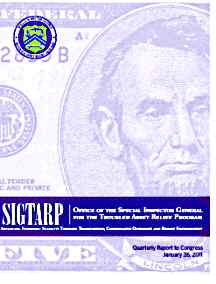Neil M. Barofsky wrote a devastating column for the New York Times on March 29, his last day as Special Inspector General for the Troubled Asset Relief Program (SIGTARP). The roles for his position were:
"to conduct, supervise, and coordinate audits and investigations of the purchase, management, and sale of assets under the Troubled Asset Relief Program ("TARP"). SIGTARP is required to report quarterly to Congress describing SIGTARP’s activities and providing certain information about TARP over that preceding quarter." April 21, 2009 (Image SIGTARP)
A Wharton School of Business graduate and New York University trained lawyer, Barofsky was never one to pull punches. In the New York Times OpED, he summarized the results of TARP:
"Treasury’s mismanagement of TARP and its disregard for TARP’s Main Street goals -- may have so damaged the credibility of the government as a whole that future policy makers may be politically unable to take the necessary steps to save the system the next time a crisis arises." Neil Barofsky, March 29
In other words, TARP was such an anti-citizen enterprise; its conduct may well prevent future rescue operations. Poorly managed, the program did nothing for Main Street. Barofsky noted that,
"Treasury promised that it would modify those mortgages to assist struggling homeowners. Indeed, the act expressly directs the department to do just that." This was a central piece of the legislation. It provided members of Congress with the cover that they needed to finally pass the troubled act." Neil Barofsky, March 29
What did the United States Department of the Treasury do once they had control of TARP?
"Almost immediately, as permitted by the broad language of the act, Treasury’s plan for TARP shifted from the purchase of mortgages to the infusion of hundreds of billions of dollars into the nation’s largest financial institutions, a shift that came with the express promise that it would restore lending." Neil Barofsky, March 29
We know how well that worked.
TARP Bait and Switch
Secretary of the Treasury Robert Paulson said it TARP would help "struggling homeowners" and stimulate lending. Instead, TARP was used, almost exclusively, as a a means to fatten up the fattest cats of all, the big banks.
Economic Populist's Robert Oak summed up Barofsky's assessment of tarp after his October 26, 2010 quarterly report to Congress:
SIGTARP, aka TARP Inspector General, has released a new report (large pdf) on TARP. Here are the grades per TARP's own stated objectives.
- Increase lending to small business? FAIL
- Decrease Unemployment? FAIL
- Preserve Homeownership? FAIL
- Remove Moral Hazard? FAIL
- Reduce Financial Sector Size? FAIL
In his final report, January 26, 2011, the special inspector general reported that the overall cost of TARP had been recovered leaving just a $25 billion dollar price tag. He claimed that TARP was critical to preventing a financial collapse.
As he gave with one hand, Barofsky delivered a devastating right hook with the other:
"By effectively guaranteeing these institutions against failure, they [Treasury] encouraged future high-risk behavior by insulating the risk-takers who had profited so greatly in the run-up to the crisis from the consequences of failure, and gave an unwarranted competitive advantage, in the form of enhanced credit ratings and access to cheaper credit and capital, to institutions perceived by the market as having an implicit Government guarantee." Neil Barofsky, SIGTARP, January 26, 2011
Barofsky hammers home the point that the very institutions whose reckless behavior caused the financial crisis received lavish rewards at taxpayer expense, with an all but explicit government guarantee that assured their survival.
He went on to compare this coddling to a "toxic cocktail."
"In many ways, TARP has thus helped mix the same toxic cocktail of implicit guarantees and distorted incentives that led to disastrous consequences for the Government-sponsored enterprises (GSEs) -- the Federal National Mortgage Association (“Fannie Mae”) and the Federal Home Loan Mortgage Corporation (“Freddie Mac”)." Neil Barofsky, SIGTARP, January 26, 2011
Barofsky summed up his opinion of the entire affair in the Times piece:
"In the final analysis, it has been Treasury’s broken promises that have turned TARP … into a program commonly viewed as little more than a giveaway to Wall Street executives."
Last Minute Job Switch at SIGTARP on Barofsky's Exit
Barofsky submitted his resignation on February 14, effective March 30. Just prior to this announcement, "[Christy] Romero was Barofsky’s chief of staff until today, when she and Geoffrey Moulton, who had been deputy special inspector general, switched jobs." Bloomberg, February 14
The job switch assured that Romero became acting SIGTARP, succeeding Barofsky. Law school professor Moulton assumed the position of SIGTARP Chief of Staff, reporting to Romero.
Romero, a Brigham Young University School of Law graduate, was the Chief Counsel to the former chair of the Securities and Exchange Commission Christopher Cox and current chair Mary Shapiro. Romero left the major DC law firm of Akin, Gump, Strauss, Hauer, & Feld to join Barofsky's staff. Moulton once clerked for US Supreme Court Chief Justice the late William Rehnquist. He also was staff director for the US Department of Treasury administrative review of the Waco massacre. Since that time, he has served as an Assistant US Attorney twice and teaches at the Widener School of Law, University of Delaware.
It is reasonable to assume that the current hierarchy at SIGTARP reflects Barofsky's preferences.
Is this the order of battle to begin the rumored legal actions against AIG or are they just caretakers awaiting a Timothy Geithner suggested appointment by President Barack Obama?
END
This article may be reproduced entirely or in part with attribution of authorship and a link to this article.


Recent comments